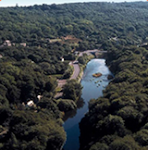Wednesday 6th August 2025, Oswestry Old Racecourse
Oswestry Old Racecourse is situated on a plateau at about 1000ft above sea level, to the west-north-west of Oswestry. It is now an area of open woodland, scrub, rough and unimproved grasslands, and heathland which is slowly being restored on the north of the site.
Spoiler alert! We did not make it to the heathland part of the site.
The track, when it was a racecourse, was shaped like a figure of eight and about 3km long. A grandstand was constructed at some point, but this is now in ruins.
Racing started in the 18th century to cater for local sporting activity but ceased in 1841 after increasing gambling and crime at the event had deterred people from attending.
After leaving, reluctantly, the car park we started on one of the main rides through the site heading south. We did not head far before settling down for an exploration of our immediate surroundings.
After quite a while rooted to this spot, a breakaway movement formed who forged ahead to the south of the site, which should have been a wide expanse of grassland. But in one patch succession was taking place, as birch saplings had taken over and covered the ground.
Getting past the sapling infested area we came to the grassland, where the breakaway party settled down to do more searching for invertebrates and other things of interest.
Eventually the others caught up.
My “objective” at this point was to lunch at the Grandstand, but we were in danger of not getting that far.
Again, a breakaway occurred as a few of us headed to the lunch target.
Here is the peace and quiet offered by this relic of the past.
And here it is when the rest of the group arrived and were fortified by sandwiches, fruit, drink and whatever other foods they consumed.
The area in, but mainly around the grandstand, was very productive in terms of species found as there was plenty of floral interest, attracting bees and supporting other invertebrates.
We were in danger of spending the rest of the day there when …
You probably have guessed it …
A few broke away to continue down the wide area of grassland between the western edge of the site and the woodland between us and the car park.
The pattern repeated itself as the advance party settled down in an area of rougher grassland by the edge of the woodland.
The rest eventually ambled up to join them.
And we remained here until the end of the day approached.
But …
Yet another break-out as some returned to the Grandstand!!
They were attracted, like the bees, to the flora.
Time to go home.
A few of us led the way through a maze of small footpaths through the woodland until we chanced upon a picnic table by the car park.
The opportunity to sit and wait for the others was too great to resist.
During this time, the traditional “one last vac” was carried out, searching some rough vegetation at the edge of the car park.
This resulted in finding a fly that has only been recorded in the county once before, Stiphrosoma laetum.
Is that the only photograph of the fauna from the day?
The answer is, of course, “No”.
Here are some of the things we found.
An excellent day for harvestmen included:
A male and female Mitopus morio;
Opilio parientinus;
And Phalangium opilio.
And here are the rest that were photographed.
A lacewing larva, with its impressive jaws waiting for any unsuspecting prey.
Two forms of the 10-spot Ladybird, Adalia decempunctata.
 |
| the typical form f. decempunctata; Photograph: Nigel Cane-Honeysett |
 |
| f. decempustulatus; Photograph: Nigel Cane-Honeysett |
An Eyed Ladybird, Anatis ocellata.
A spider, Clubiona reclusa, with its egg-sac.
Two Dock Bug nymphs, Coreus marginatus.
Two Common Earwigs, Forficula auricularia.
A Forest Bug, Pentatoma rufipes.
And finally a gall, Taphrina caerulescens, caused by a fungus found on Red Oak.
My thanks to Shropshire County Council for permitting us to do what we enjoy doing and to the photographers for their excellent images.
Scaly crickets
You may have noticed that a major contributor of images for our reports is missing from the selection offered above. That is because he was in Pembrokeshire searching for Scaly Crickets, Pseudomogoplistes vicentae.
He was successful.
And kindly sent these images.
A nymph.














































No comments:
Post a Comment
Please feel free to comment on this post...